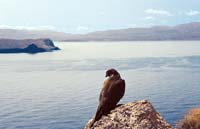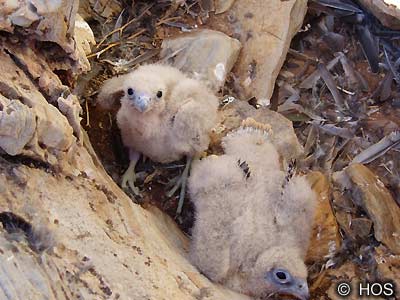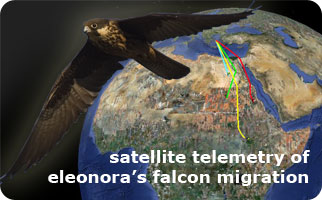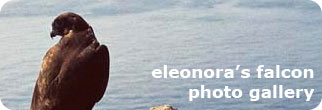|
|
 |
|
Eleonora's falcon ecology: Description of the species
The Eleonora's Falcon is a dark-coloured, average-sized migratory falcon with long wings that appears in the Mediterranean area in April, returning from East Africa, especially Madagascar, where it spends the winter (Cramp and Simmons 1980, Beaman & Madge 1998, and Clark 1999). The adult birds occur in two colour phases: one is dark, almost black, while the other, and more common one, is a light phase during which the body is a light, chestnut brown with elongated streaks. However, in open fields, even in the light-coloured phase, the bird appears to be very dark, almost black. It is gregarious, living in colonies, and some people might confuse it with the Falco peregrinus, who is, however, more strongly-built and possesses a shorter tail. Greece is considered the most significant country for the conservation and survival of the Eleonora's falcon, since during the breeding season, we now know that it hosts more than 85% of the global population (Dimalexis et al 2007). Past estimates suggest that 70% (Walter 1979) and 75% of the global population of the Eleonora's falcon breed in Greece, while one third of these breed on the islets of Crete (BirdLife International 1999, Ristow 1991). The diet of the Eleonora's falcon until the end of July, when the egg-laying has been completed, consists mainly of big insects, such as butterflies, flying ants, dragonflies, cicadas and beetles that it catches in the air with its talons, above islands or the sea (Ristow and Wink 1994, Ristow 2001). During the following period and until October, it feeds exclusively on migratory birds, a food source that is, theoretically, infinite. After its breeding, between the end of October and the beginning of November, it flies to East Africa, especially to Madagascar, where it spends the winter, returning to a diet based on insects. Breeding: The unique characteristic of the Eleonora's falcon is that it breeds more slowly in relation to other birds. More specifically, its breeding season begins much later (in July), compared to other migratory birds. Consequently, it can include in its diet the plethora of migratory bird fauna species that fly over the Mediterranean basin during the end of summer, heading for the South (Walter 1970, Wink et al, 1991). Because of this, travel is generally not observed between the island where it breeds and the mainland - with only exception the days when it is very hot and not even the slightest wind is blowing (Ristow et al. 1983) - since the mature individuals and the chicks feed on birds from the autumn migration wave. The species basically nests in natural rock cavities that are located on small islets, on cliffs of islets and larger island, but also in rocks located in the interior land. Indeed, it is believed that it displays consistent use of its nesting place as well as monogamous habits. However, according to existing data, the phenomenon of dispersion of young birds during the first years of their life can be observed. Thus, according to Ristow et al. (1979), about 90% of the young individuals that do not breed during the first 2 or 3 years of their life are absent from their birth colony during the period May to October, but return and settle down in the following years. Every couple of Eleonora's falcons gives birth to one to three eggs, while the chicks hatch at the end of August. Thus, there is, as mentioned above, an immense migratory wave of birds that offers an easily accessible as well as ample food source. The chicks develop plumage after 35 days and so, from mid-October on, the populations start migrating towards East Africa and Madagascar, where they spend the winter. |
|
|









